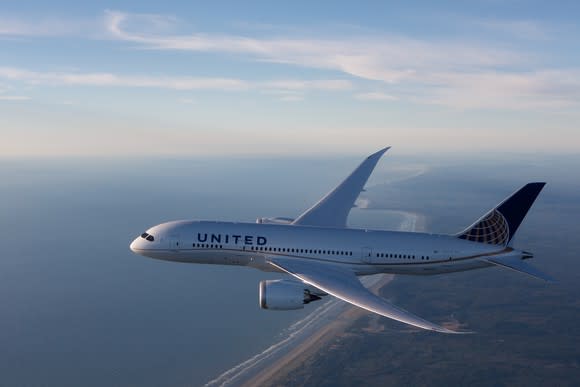Profit Plunges Again at Floundering United Continental Holdings, Inc.
On Wednesday afternoon, airline giant United Continental (NYSE: UAL) reported that adjusted earnings per share totaled $2.22 for the third quarter, beating the average analyst estimate by $0.10. United's adjusted pre-tax margin of 10.4% came in near the high end of its most recent guidance range.
Still, this could hardly be considered a good result. Adjusted EPS declined a whopping 29% year over year, as unit costs rose while unit revenue fell. Furthermore, United is bracing for another steep margin decline in the fourth quarter. While management has repeatedly stated that United Continental is on track to match or exceed Delta Air Lines' (NYSE: DAL) profit margin by 2020, United is actually falling further behind.
United serves up another subpar quarter
Back in July, United projected that passenger revenue per available seat mile (PRASM) would be roughly flat year over year in the third quarter. However, the combination of a self-inflicted price war and hurricane-related revenue losses led to a 3.7% PRASM decline instead.

United's return to unit revenue growth in Q2 was short-lived. Image source: United Airlines.
Hurricane-related flight cancellations also drove up unit costs, with rising fuel costs creating even more earnings pressure. As a result, United's adjusted pre-tax margin plummeted to 10.4% from 15.6% a year earlier. This is unacceptably low, considering that the third quarter includes the summer peak travel season.
This isn't just a case of bad luck
Hurricanes and fuel prices are obviously outside of management's control. Nevertheless, it would be wrong to write off United's poor third quarter earnings performance as a case of bad luck.
First, Delta Air Lines faced the same headwinds (more or less) and produced much better results. Delta's adjusted pre-tax margin declined by just 2.6 percentage points year over year last quarter: half of United's decline. Meanwhile, its pre-tax margin of 15.6% was more than 5 percentage points ahead of what United Continental achieved.
Second, United Continental's fourth quarter outlook is equally dismal. Management expects PRASM to decline 1%-3%, with most of the decline concentrated in December. Rising fuel prices and non-fuel unit costs will also weigh on profitability in the coming quarter. The net result is that United expects to post an adjusted pre-tax margin of 3%-5% in Q4, down from 9.5% in the fourth quarter of 2016.
Hurricanes can't be blamed this time. While United does expect some lingering effect from Hurricane Harvey on demand at its Houston hub, this doesn't explain the extent of its projected margin decline.
Not surprisingly, Delta is likely to post much stronger results in the fourth quarter. Delta's forecast calls for solid PRASM growth of 2%-4% this quarter and an operating margin of 11%-13%. This would translate to a pre-tax margin of roughly 10%-12%.
Next year?
At its 2016 investor day, United Continental's new management team laid out a plan to "close the margin gap" relative to Delta Air Lines by 2020. This entailed specific initiatives to boost pre-tax profit by $4.8 billion over that period.
According to the plan, United should have captured $1.8 billion of that profit improvement opportunity in 2017. Instead, the company's adjusted pre-tax margin is on track to sink to around 8% this year, down from roughly 12% in 2015 and 2016.
United's management is hopeful that results will improve quickly starting in 2018. Non-fuel unit costs are expected to rise by no more than 1% annually over the next three years. Meanwhile, some of the carrier's recent network and scheduling changes should start to pay off.
On the other hand, due to a recent uptick in oil prices, United's fuel costs are likely to increase again next year. Furthermore, United Airlines is facing an influx of competition in some of its key markets. Finally, the carrier will face much tougher year-over-year revenue comparisons in the first half of 2018 than it has in 2017.
Delta Air Lines is set to extend its already-significant margin advantage over United Continental in 2017. Delta also expects to enter 2018 with strong unit revenue momentum, whereas PRASM will likely decline at United this quarter. As a result, despite United's various profit improvement plans, it's hard to feel confident that this perennial laggard will find any more success next year in its elusive quest to match Delta's margins.
More From The Motley Fool
Why You're Smart to Buy Shopify Inc. (US) -- Despite Citron's Report
6 Years Later, 6 Charts That Show How Far Apple, Inc. Has Come Since Steve Jobs' Passing
NVIDIA Scores 2 Drone Wins -- Including the AI for an E-Commerce Giant's Delivery Drones
Adam Levine-Weinberg owns shares of Delta Air Lines. The Motley Fool has no position in any of the stocks mentioned. The Motley Fool has a disclosure policy.

 Yahoo Finance
Yahoo Finance 